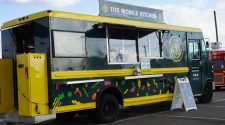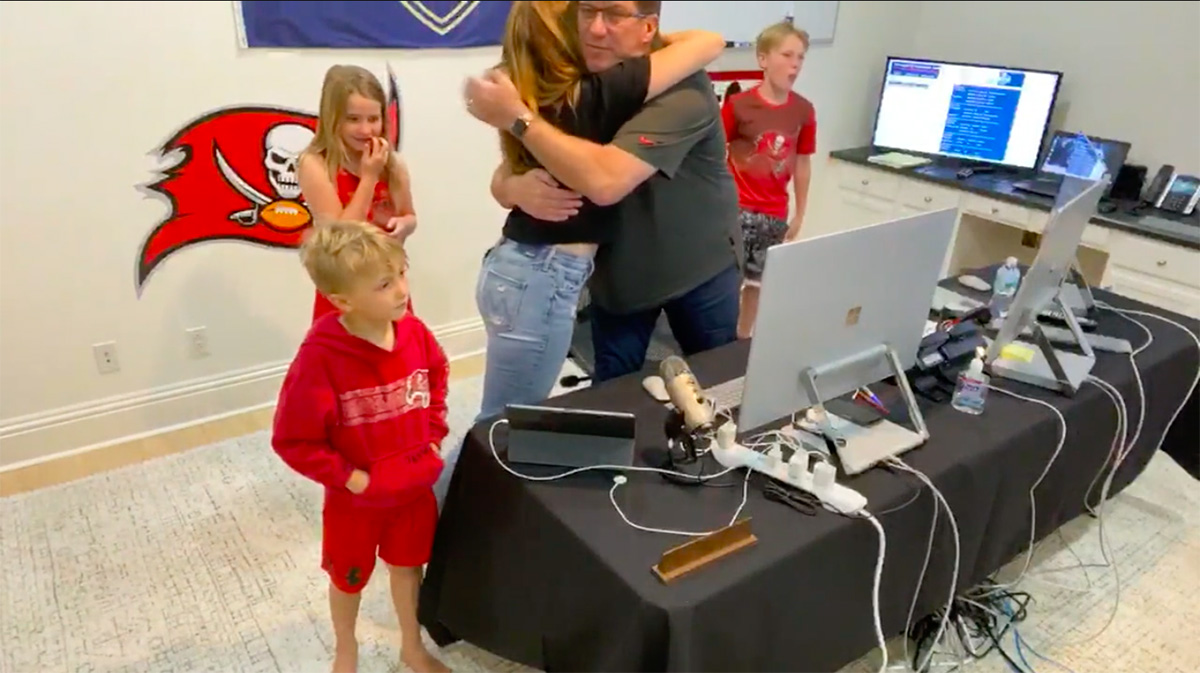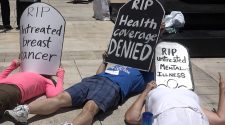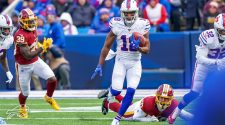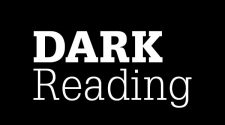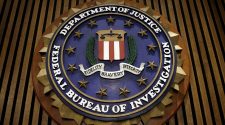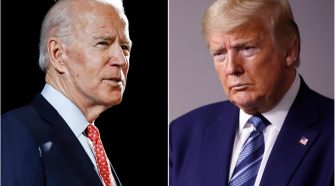What the 2020 NFL Draft would have been like, Vegas style:
Roger Goodell, from an island in the middle of the luxe pond just off the Strip in Las Vegas, announces to the crowd of 750,000 and to America: “With the 24th pick in the 2020 NFL Draft, the New Orleans Saints select Cesar Ruiz, center, Michigan.” . . . The ESPN camera posted on a high wall in the Saints draft room shows a grainy coach Sean Payton and GM Mickey Loomis high-fiving . . . As three cameras zoom in on him, Ruiz, in his $3,000 custom-made suit, steps onto a little boat to take him to a red carpet . . . He puts on a Saints cap, climbs onto the red carpet to fireworks overhead, fountains pulsing on all sides of him . . . Ruiz approaches Goodell, and though he is a humble kid who’d never do this in real life, chest-bumps the NFL commissioner. They bearhug. For the cameras, Goodell holds up the black-and-gold Saints jersey with RUIZ on the back. The crowd of 750,000 goes nuts. A fist-pumping Ruiz beams in this manufactured moment.
What the 2020 NFL Draft actually was, pandemic style:
Roger Goodell, tie-less, from his wood-paneled basement 15 miles north of New York City, announces with not much verve: “With the 24th pick in the 2020 NFL Draft, the New Orleans Saints select Cesar Ruiz, center, Michigan.” . . . An iPhone on a portable tripod shoots Ruiz, in a camo T-shirt, live in his modest family home in rugged Camden, N.J. He dons a Saints cap and bawls, overcome by the moment. His mom, the rock of the family after his good-Samaritan dad was struck and killed by a car when he stopped to help a stranded driver change a tire in 2007, envelops Cesar as he weeps . . . Saints coach Sean Payton—in a hoodie, son Connor to his side, a bag of Twizzlers in front of him—watches the pick on TV in his living room. Across town at his home, GM Mickey Loomis gets a hug from son Sam, with daughter Lucy beaming nearby . . . A small group of friends and family in the Ruiz home whoop it up . . . There is no Saints jersey, no crowd of 750,000. There is middle-class America, as a family celebrates its finest hour.
Glitzy/glamorous NFL, or humble/Americana NFL. What’s better?
We saw this weekend what’s better.
It took a murderous virus to humanize the money machine that is the NFL, and to humanize a cold man who might have had his finest moment as commissioner, and to humanize the steely coach feeding treats to his miniature Husky. But that’s exactly what happened in this technologically scotch-taped 85th NFL Draft. For three days in the sports-starved United States, it was just what we needed—the one thing on the sports calendar that wasn’t cancelled, presented with the humility these times demanded.
One story: This was Joe Douglas’ first draft as the GM of the New York Jets. He’d risen through the scouting departments of the Ravens and Bears and Eagles to this mountainous gig. He’d have to draft from the impromptu setup in his New Jersey home, not in his comfort zone of the Jets draft room. His wife, Shannon, offered to keep their three children in the basement, away from his temp draft room, but he said no, he wanted them to experience it. Shannon used her iPhone to video his first pick—tackle Mekhi Becton—from just outside the room Thursday night, and when it was done, the kids burst in. His 13-year-old daughter, Addison, hugged him and said, “I am so proud of you, Dad!”
“All right, Addison,” Douglas said. “You’re making me misty here.”
The burly Douglas got misty on national TV, with about 16 million people watching. There was a lot of emotion in the best NFL draft I’ve ever seen.
Thick column. Settle in, stay safe, and digest all the oddities and goodness about draft weekend:
- Surprise! I’m in a draft room! (Virtually.)
- Much ado about nothing: Drafting 255 football players went off without a hitch.
- Back to the future, Aaron Rodgers.
- The strange journey of Joe Burrow will continue this week on some patch of grass in Appalachia.
- Denver’s in an arms (and legs) race with the Chiefs.
- John Lynch’s grade for his fourth draft: Is there something higher than “A-plus?”
- Did Roger Goodell just flip the script on Roger Goodell?
- I do believe Sean Payton might have saved someone’s life last week.
- Alex Smith’s very serious brush with death goes public this week.
- Jacob Eason is ready to sacrifice something quite important to wow the Colts.
- A humble home for Jameis Winston’s gap year.
First, the draft itself.
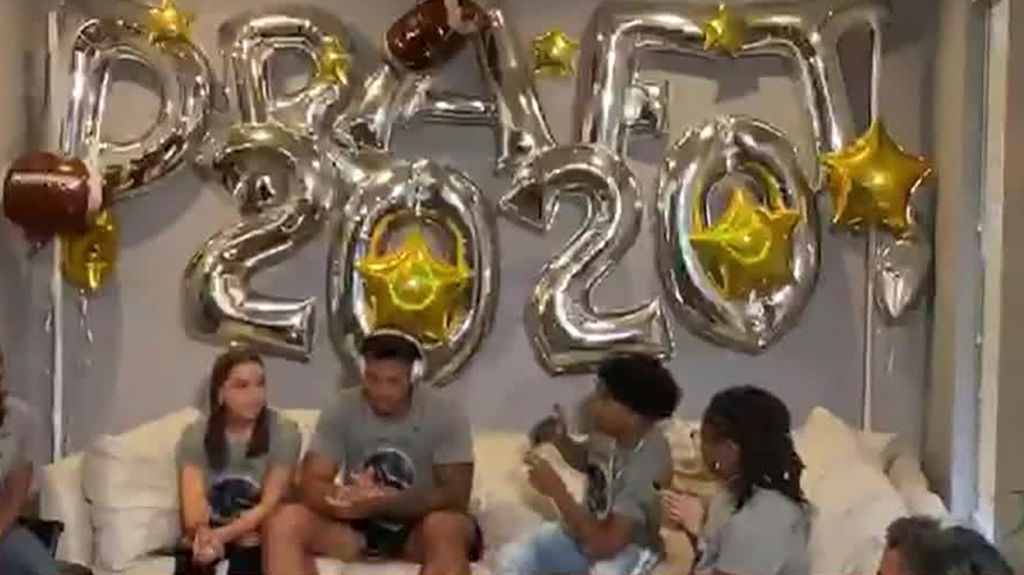
Five weeks ago, when few football people had ever videoconferenced, the NFL establishment groused about this show-must-go-on draft. Two weeks ago, the technology that would power this draft, Microsoft Teams, was a stranger to every football person in the league. A week ago, a two-minute glitch early in a practice draft reinforced the belief that some internet implosion might wreck it. The NFL set up three ways for GMs to pick 255 players, and put in place a timeout system so if some GM’s 6-year-old kid spilled a drink on a keyboard, the league would press the pause button on the draft.
I asked the league’s draft czar, NFL vice president of player personnel Ken Fiore, who has worked 31 drafts, if he had to stop the clock for any reason on any of the 255 picks over three days—if any team went over the allotted time for making choices.
“None,” Fiore said Saturday evening, two hours after the draft concluded. “Came close a couple of times, but no. It ran similar to a regular draft. The only word I can think of to describe this draft is ‘flawless.’ “
It’s a sign of the times that the nine-man Draft Ops department, headed by Fiore, worked from their homes, Fiore on Long Island and his eight lieutenants from various homes in Manhattan, New Jersey, Rochester, N.Y., Phoenix and Nashville. Fiore was one of a three-person trade group, confirming with both teams the terms of all 33 trades over three days. Draft Ops communicated the picks and trades to a mask-wearing NFL aide in Goodell’s basement, and to ESPN headquarters in Connecticut, where the live shots from among 180 remote cameras in homes of coaches, GMs, prospects and reporters were waiting to be used. From cool Joe Burrow on the couch with his parents in the living room in The Plains, Ohio, to Bill Belichick, on Nantucket giving treats to his dog Nike, to Goodell looking like he needed a nap in his leather La-Z-Boy late in the third round Friday night, to the Jets’ fourth-round pick, quarterback James Morgan in Green Bay, celebrating with his family like they’d just won the Super Bowl or the $200-million Powerball, to the glum Jake Fromm with his family, melting in Warner Robins, Ga., till he was picked in the fifth round . . . all so human. So without frills. So 2020 America.
On Sunday, ESPN vice president of production Seth Markman said that, other than a few slight delays between anchor Trey Wingo and field reporters and players, the telecast had no significant technical issues. “I loved how everyone embraced it,” Markman said. Nobody moved the camera, nobody covered the camera, nobody seemed annoyed. Coaches and GMs with families were great—people will never forget Bill Belichick and his dog. They all embraced this new reality.”
The public got to see things it never does, instead of the awful war-room shots that are so 1993. The Matt Nagy game plan wall, the John Harbaugh birdhouses, the Jerry Jones yacht, the Matt Rhule kid cheerleaders, the Kliff Kingsbury Architecture Digest living room, the kids, the kids, the kids. As Douglas told me: “My experience in the NFL is, you get in the weeds of draft prep, and then you draft, and you get home after midnight, and everyone’s asleep. You never experience the draft with your family. This year was an unintended plus. I loved being together for it.”
Give credit to NFL people who treat this weekend, rightfully, as being as important as a game week. More important to some franchises. They recognized the condition of the country, and the role the NFL played in it. Saints GM Mickey Loomis, who wanted the draft pushed back for more info-mining, said Saturday night he loved having his kids involved, loved that the league raised so much money for COVID-19 relief and this: “The concerns many of us had related to technology did not materialize. For us, nothing went wrong.”
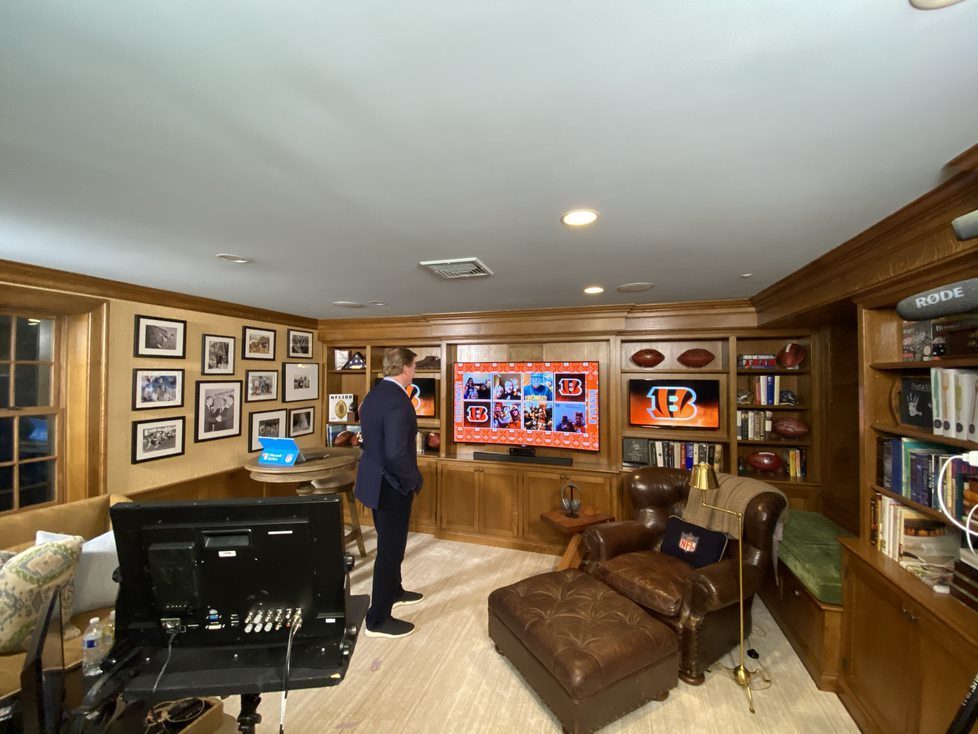
And give credit to Goodell. This was the best achievement of his 13-year term since the midnight CBA agreement in late July 2011. He thought the technology was there for teams to handle drafting from their homes; it was. He thought America needed three days of sporting normal; it did. He thought a more humble, lower-key draft was the way to go; it was.
“I want you to quote me on this,” Denver GM and VP John Elway told me Friday night. “Roger Goodell had a lot of pressure on him entering this draft. I will tell you a lot of GMs and some owners didn’t want it to happen right now, but Roger held strong. He had forethought about what this country was going through, with people quarantined, missing sports, needing some normalcy. I just think he deserves a hell of a lot of credit for standing up and going forward with this. That’s great leadership.”
I wouldn’t call the 2020 NFL Draft a healing moment for the country, or something that sappily dramatic. Rather, it was a needed event, done well, hitting the right notes. As Loomis said: “It was just . . . [pause] . . . human.” Great to see.
Each year before the draft, I try to find a team where I can embed. Some years I succeed (Cowboys, 2016; Niners, 2017), some years I don’t. But I thought this year it was important to find a team because of the unique nature of the draft. The Bucs, via GM Jason Licht, agreed. I was able through virtual connection to witness much of the first round through Licht’s eyes. This should give you some idea of how NFL teams functioned with coaches, GMs, owners and scouts virtual islands for one of the biggest weekends on the NFL calendar.
After about 50 minutes of discussing merits of trades with his staff on Cisco WebEx videoconference and talking trades via cell phone with other GMs and judging the value of trades on his three tablets (the better to measure competing offers for picks), and studying draft needs of the other teams in front of him in the first round on a huge Surface Studio desktop, Tampa Bay general manager Jason Licht could finally breathe. This was about 9:47 p.m. ET on Thursday. Licht was in the toyroom of his Tampa home, the best big space available in his home for a GM to run a draft, and his three kids had decorated the room with a Bucs Pirate Fathead and a hand-colored GO BUCS 2020 NFL DRAFT sign behind Licht’s desk.
The Bucs had just traded with San Francisco to move from 14 to 13 in round one of this unusual NFL draft. Director of college scouting Mike Biehl, from his Tampa home, logged onto the Bucs’ encrypted Microsoft Teams channel with about a minute left in the 10-minute drafting period to report the first pick of the 2020 draft for the Buccaneers to NFL draft headquarters. Biehl filled in the round, the overall pick in the round, the player, his school, his position, and a special code that only the Bucs employee reporting the picks would know:
1
13
Tristan Wirfs
Iowa
Tackle
XXXXX
Return confirmation. The pick was made.
Licht got up from his chair and hustled to open the door. “Come on in, guys!” he yelled, and in a flash 11-year-old Charlie, 9-year-old Zoe and Theo, 6, roared in, followed by wife Blair. The kids high-fived Dad, who told them they took a big guy from Iowa named Tristan. “Excited, babe?” Blair asked. “SUPER excited,” Jason Licht said.
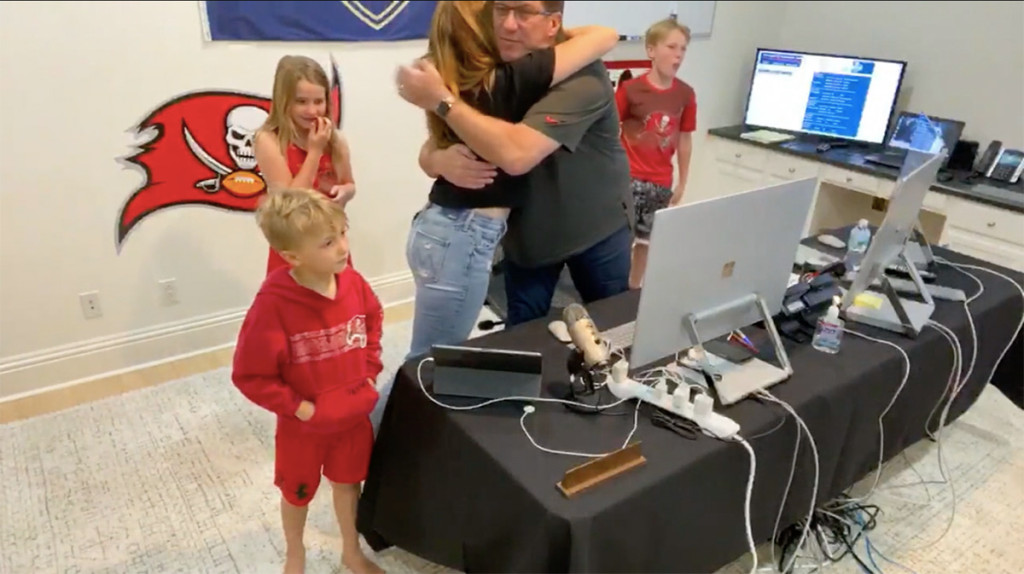
Theo got on his dad’s lap. Jason Licht, as if he was talking at a staff meeting or an offsite, knowing the work for round one was done, looked at the videoconference screen and told his staff and coach Bruce Arians: “Good job guys! You can fix yourselves a cocktail now!”
Then the hilarity of the moment hit him, and he said in a voice approximating dazed: “First trade ever in a virtual NFL draft!”
Unintended Consequences of Draft Prep at Home Dept.:
Charlie Licht, the 11-year-old son of Tampa Bay GM Jason Licht, has made friends with several kids of NFL GMs from league functions. He plays Madden with some of them. Hanging around his dad while Jason Licht made a slew of pre-draft trade inquiries was fascinating for Charlie, but Dad at one point thought son might have heard too much. “Charlie,” Jason said to him one day, “you CANNOT tell any of those kids what I’m thinking if you heard anything.”
It was that kind of draft this year: Kids had to learn what “off the record” means. Everything was new. Licht’s never home this time of year, and now he was captive in the house for five weeks. Licht said: “The kids got used to me being home and just walked into the office sometimes. I got used to walking out to the kitchen for a snack. We had all our meals together, like a normal family. It really was a new reality for us.” Watching him on draft night when his kids walked in, you could tell how at ease they all were with each other.
To allow me to be able to observe the reality of the Tampa Bay first round, the Bucs’ IT guy, director of football information Spencer Dille, put a tablet to the right of Licht’s desk and turned it so I could see and hear Licht’s movements. I watched Licht for about 15 minutes at the start of the draft, and then around the time Arizona was picking at eight, six picks before Tampa Bay’s turn. That’s because, though Licht wouldn’t say for sure prior to the draft, it was possible the Bucs would trade up for their targeted player, and if that player got picked at eight or nine or 10, I’d obviously need to see it to write about it.
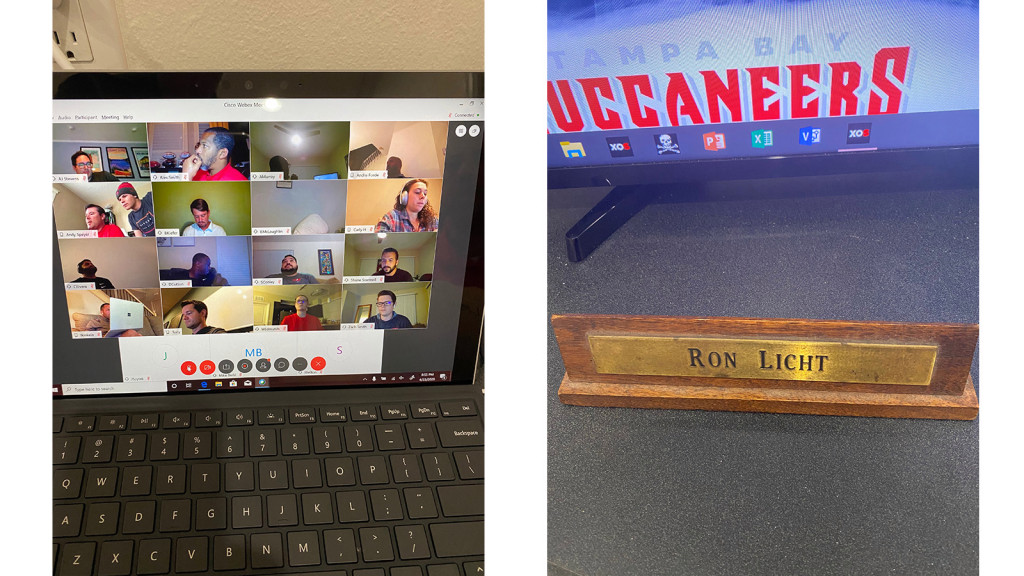
Dressed in khakis, sneakers and a polo shirt, Licht seemed at ease. On his desk was a weathered nameplate: RON LICHT. That was Jason Licht’s father. He died last September attending a Nebraska football game; the Lichts are Cornhusker lifers. Jason Licht wanted to feel his dad close to him in the first draft after his father passed. A prepared man usually is not nervous. It looked like that to me.
Later, Licht would tell me: “I was incredibly surprised I didn’t get upset at some point, especially when we were trying to make the trade. When this new way of doing business started, I was nervous. Not freaking out, but really on edge, hoping they’d push the draft back. I wondered how quickly I’d be able to master all these new technologies.” Five weeks of videoconferencing was just the tonic. For the next hour or so, I watched Licht mute and unmute his screen with his braintrust—coach Bruce Arians, director of player personnel John Spytek, director of pro scouting Rob McCartney, Biehl the college czar, and director of football administration Mike Greenberg—while working the phones and thinking. That’s the underrated part of drafting. Sometimes a general manager has to find 15 seconds to shut everything off and just think about the deal he’s been offered and whether it’s a smart one to take. I wondered whether Licht would have to make that kind of call in this draft.
In timeline and techie form, how the Bucs made their first-round pick:
9:12 p.m. ET Trading is tough. Licht made about 30 calls during the week, up and down, to see which teams might want to go up or down in the top half of the draft. Tonight, Carolina (picking seven) is a no. “I don’t think they’d deal even if we offer next year’s one,” McCartney, who’d been the Panther contact, tells Licht. Arizona (eight) has to be a no. GM Steve Keim won’t pick up Licht’s call. Licht: “He’s one of my best friends, and he told me, ‘If you want to come up, gimme a call.’ Now he doesn’t answer.” Someone on the videoconference says to Licht: “Got a hold of Jacksonville yet?” Jacksonville (nine) has not been eager to move out.
- Carolina takes defensive tackle Derrick Brown.
9:13. Licht picks up his cell and calls Jacksonville GM Dave Caldwell. “We’ll give you our three and four. [Picks] 76 and 117 . . . all right . . . call me back.” Licht tells his Cisco Webex crew: “Jacksonville’s thinking about it. Straight up, 76 and 117.”
- Quickly, Arizona, entertaining nothing, takes versatile defender Isaiah Simmons.
9:15. R-r-r-r-ringggggg! The alert on Licht’s phone sounds like the old-fashioned ringer on the Perry Mason Show. “Hello,” Licht said, answering it. “Okay. Okay . . . Okay.” Hangs up. Says to Cisco crew: “Jacksonville’s out. They’re taking [cornerback] C.J. Henderson.”
9:17. (Voice from Cisco) “Who you talking to in Cleveland?” GM Andrew Berry is Licht’s contact. Licht: “What I’m worried about is these two teams are tackle teams.” Cleveland (10), the New York Jets (11) are next. In pre-draft calls, both seem motivated to trade down.
9:19. Licht calls Berry. “Andrew, how you doing? You gonna sit there and pick?”
- Jacksonville takes C.J. Henderson.
9:21. Licht calls Jets GM Joe Douglas on his cell. “Joe, how you doing? . . . Okay, call me back . . . Yeah . . . It’ll be for what we talked about. We’ll come up.” Off the call, Licht reports to the Cisco gang: “Joe says they got two guys here. If Cleveland doesn’t take one, he might move. I’m guessing Joe wants [Louisville tackle Mekhi] Becton.
9:23. Staring at screens. The waiting is the hardest part.
9:24. Licht: “Somebody get ready to call the Raiders.” McCartney calls GM Mike Mayock of Las Vegas (12) to find out his status.
- Cleveland takes Alabama tackle Jedrick Wills.
9:25. Two tackles left. Pretty easy to see now that Tampa Bay wants a tackle. But which one? Licht calls Douglas. “Hey,” Licht says, “what are you doing?” Off the phone in 12 seconds. Licht to the Cisco gang: “They’re picking. Says they’re picking the guy large and in charge. Must be [364-pound] Becton.”
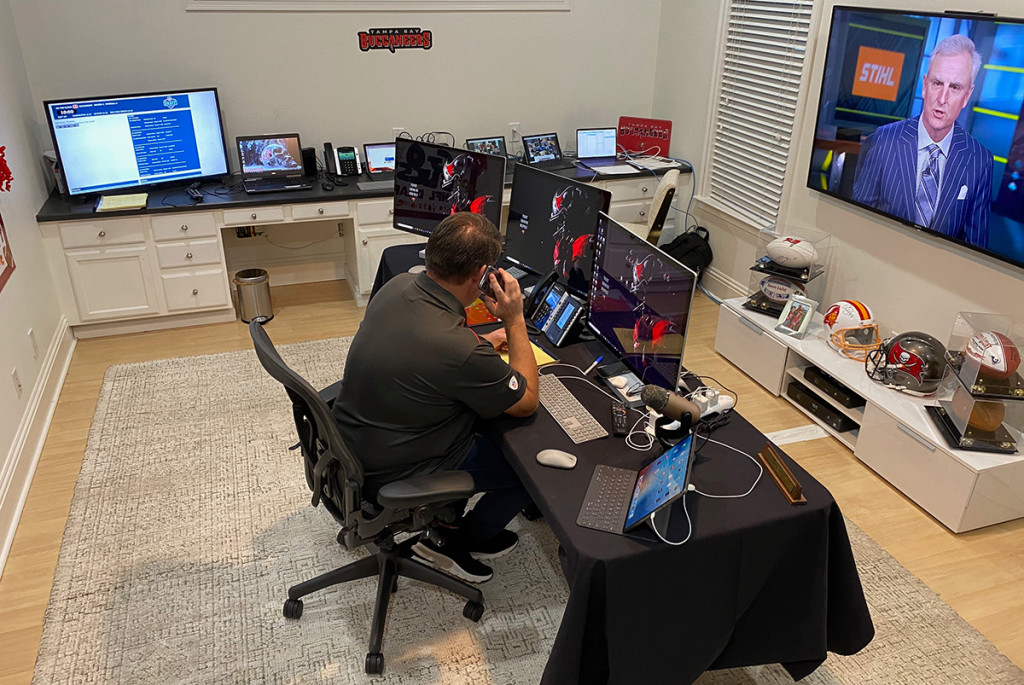
9:26. Frustration. Licht stays pretty cool, but he’s tensing up. Nobody wants to trade—for anything! When’s the last time the draft was 11 picks deep without a trade? The Raiders (12) are next. The Bucs are sure they’ll take a receiver, which makes them a good target. Mayock knows the Bucs, at 14, won’t want a receiver. To the Cisco gang Licht says: “I like giving ‘em the three and four and getting back their three. (Tampa trading 14, 76 and 117 and getting 12 and 81 back.) Much debate back and fourth. Just offer the four, someone suggests. Our three, five and six and they give us their three back, another suggests.
- Jets take Louisville tackle Mekhi Becton. Raiders on the clock.
9:29. Voice on Cisco: “Minnesota [22] just called.” Licht, suddenly: “Too far back. No.”
9:30. Suddenly, a distant “MOMMY!!!!!!” Seriously. One of the three kids yelled for Mom, and it’s audible in the room. Licht stares at a screen. He never heard it.
9:32. Licht takes a moment. Raiders on the clock. Should he up the offer? Yes. He will. He calls Mayock and offers three, five and six while getting a three back. “Okay. Okay. Thanks Mike.” Licht hangs up and tells the Cisco group: “Doesn’t matter what we offer. They’re staying.” You can sense the disbelief. Later, Licht said: “Everybody was looking at each other on the videoconference, kind of putting their hands up, like, I don’t know what the hell’s going on here. Nobody wants to give us their pick. I was getting a little bit antsy, I should say.”
9:33. Thinking. Staring. No talk. Two minutes go by. Niners are next.
- Raiders take wide receiver Henry Ruggs.
9:36. “I don’t think we can mess around here,” Licht says, as San Francisco (13) goes on the clock. But why? Why not just sit at 14 and pick the last tackle of the great prospects, Tristan Wirfs of Iowa? Licht had some intel that Niners starting left tackle Joe Staley was going to retire. So the free world was certain this next pick for the Niners was a great wide receiver or Javon Kinlaw, the defensive tackle who could replace the traded DeForest Buckner. Licht said: “Call A.P.” John Spytek, the personnel director, had been talking with San Francisco VP of player personnel Adam Peters during the week. Licht wanted this deal, and he wanted it now. “The Staley stuff scared me,” Licht said later. “The Niners could definitely be a tackle team.”
9:37. The GM side of Licht’s brain didn’t want to move up one spot and surrender a good pick (fourth round, 117 overall), while getting a seven in return. He know it might take that, but he wasn’t ready to make the offer yet. “A six,” he tells Spytek. “Start with that.” Spytek calls Peters.
9:39. Spytek calls Peters again. Is on hold with him. “They’re thinking,” Spytek tells the group.
9:40. Still on hold.
9:41. R-r-r-r-ringggggg! Licht’s phone. He answers it, annoyed. “Nothanksnothanks,” he says quickly and hangs up. Trade offer he had no interest in. All that matters now is the Niners. Spytek has made the final offer: San Francisco trades a one and a seven (13 and 245) to Tampa Bay for a one and a four (14, 117).
9:42. Waiting.
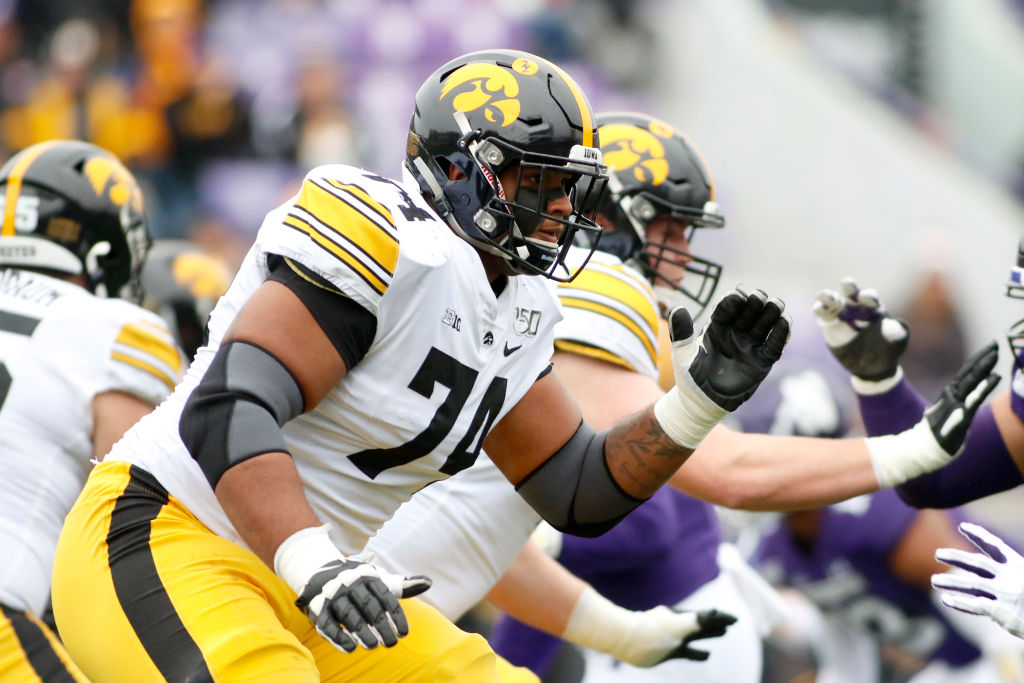
9:43. Niners say yes, Spytek reports. “Do it,” Licht says. Licht looks at the clock. Just 1:31 remains in the Niners drafting period. Now Greenberg calls NFL trademeister Ken Fiore to report the deal; a Niners counterpart does the same to another member of Fiore’s team.
9:44. “We good?” Licht says to the Cisco group. Yes, he’s told; trade accepted. Mike Biehl fills in the card for the league office, notifying them of the pick. Licht looks at the clock . . . 45 seconds left in the period. Plenty of time!
9:45. Licht dials Tristan Wirfs, in Mount Vernon, Iowa, to tell him (not in so many words) that he’d better get ready to block for Tom Brady. “Tristan!” he says. “Jason Licht with the Bucs. We just moved up to San Francisco’s pick here. We’re gonna take you . . . Okay? . . . Yeah . . . Coach is gonna call you. FIRED UP!”
9:48. Kids rush in. Charlie wants to know the deal. “They got our fourth-round pick, we got their seventh-round pick, we got Tristan Wirfs,” Dad says to son. On TV, the words come up. “TAMPA BAY. THE PICK IS IN.”
9:50. Kids hopping around. Licht says to Cisco: “Just got a text from a GM: ‘Our highest-rated tackle.’ “
Sunday morning. Draft over. Licht and the family are prepping for a bike ride, away from crowds, on a sun-splashed 82-degree Tampa day. He needs a day to decompress from the strangest experience of his scouting life.
“I gotta be honest with you,” Licht said, and he laughed. “I loved it. I loved it! I was still able to have the conversations I need to have. The private conversations. There are times when the GM and the head coach need to have private conversations. Normally I would walk out of the draft room and I would say, ‘BA [Bruce Arians], got a second?’ Instead of walking out of the room, we’d mute ourselves. Or I’d text him and he’d call me back.
“Here’s what’s crazy: I’m almost at the point where I like working this way, I’m getting so much done. And going back to the office . . . it’s going to be different. It’s amazing how much we’ve been able to get accomplished working this way.”
I could not get to all 32 teams this weekend. Next week, I plan to cover a few of the teams I missed.
Green Bay: Did the Packers backstop Aaron Rodgers too soon?
1992: GM Ron Wolf trades a first-round pick to Atlanta for backup quarterback Brett Favre, a second-round pick in the 1991 draft.
2005: GM Ted Thompson uses a first-round pick on Cal QB Aaron Rodgers, with Favre, 35, having some prime years left.
2020: GM Brian Gutekunst trades up to use a first-round pick on Utah State QB Jordan Love, with Rodgers, 36, having some prime years left.
I sense a trend among the last three Green Bay franchise stewards.
Had I written live Thursday night, or even Friday morning, I’d have been highly critical of this. I’d have said the Packers should have sat at 30 in the first round and taken the best receiver (Michael Pittman? Tee Higgins?) available. And I’m absolutely not sure, still, that they shouldn’t have done that. The Packers have done a terrible job, capital T, in surrounding one of the great quarterbacks of recent times with receiving talent in mid and late-career (more on that later in the column). This was the second straight year that Gutekunst, with a major receiver need, didn’t draft a receiver at all, and didn’t sign a prime one in free agency.
But let’s look at the Love pick this way: Rodgers turns 37 in December. He told me in 2018 he wanted to play till he was 40 if he could continue to meet the athletic demands of the position. “My goal is be able to move like I do or close to how I do and still be able to do that at 40 . . . just because nobody’s been able to do that,” he said. He’d be near the end of his fourth season from now when he turns 40. What’s the worst thing that happens if Rodgers is a top-five quarterback for the Packers for the next four years? Green Bay, maybe, pulls a Garoppolo and deals Love for what it can get in 2023. If Rodgers, motivated by this cattle-prod of a draft pick, plays great for the next four years and Love never gives Green Bay anything but a future second or third-round pick, that would mean Green Bay bought an insurance policy for Rodgers that it never had to cash in. And if Rodgers continues to be great, Gutekunst said Sunday, regardless of the Love pick, “That’d be great for the Packers.”
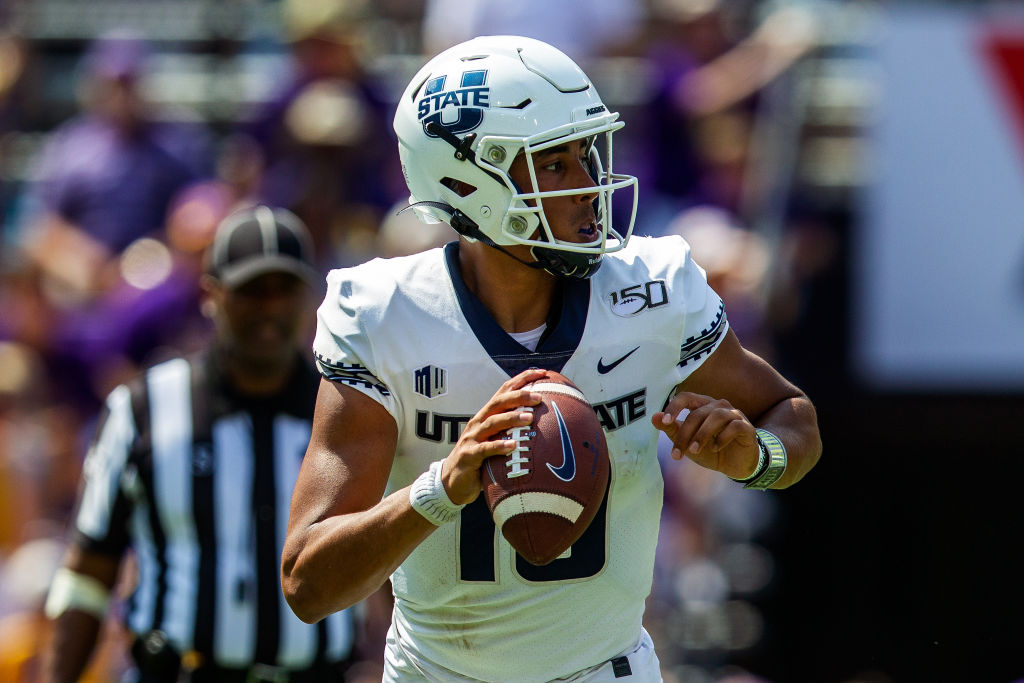
Of course, there are other angles to consider. Rodgers is a prickly guy at times, and whenever the team gets ready to practice or play, how he accepts this new reality as the leader of the team will be something to monitor. Could Rodgers think second-year head coach Matt LaFleur is not as all-in on him for the future as he thought? And if the Packers are going to exercise Love’s fifth-year option—likely to be around $22 million in 2024 if he doesn’t play much in the next three seasons—aren’t they going to want to see something from Love on the field before then?
Gutekunst told me Sunday that the Packers didn’t enter the draft thinking they’d pick Love; he thought Love might be gone in the teens or early twenties. But they had him ranked so well on their board that once he started falling through the twenties, he became a target. With significant intel that a team drafting high in the second round—perhaps Indianapolis, at 34—was trying to trade up for Love, Gutekunst felt he had to trade up to have a chance at Love. He traded up four slots, with Miami.
“I’m very hopeful Aaron continues to play at a high level for years to come,” Gutekunst said. “I know a lot of people are saying this puts a clock on Aaron, but I don’t see that at all. We prioritize the quarterback position, and have for a long time with this franchise. I remember one year in camp they had Brett Favre, Ty Detmer, Kurt Warner and maybe Mark Brunell. It’s one of the most important positions in sports, and if you don’t have one, you can’t win.”
Gutekunst, like Wolf and Thompson, views the draft as a continuum. As they did, he’s concerning himself with 2028 as well as 2021. Again: You can differ with his thought process and the major receiver he could have addressed with the 30th pick. But the importance of the position, to Gutekunst, overrode that.
“Ron traded a one in 1992 for Brett, who’d been a second-round pick and wasn’t even starting for Atlanta,” Gutekunst said. “Imagine the media fervor if that happened today. I believe if you’re going to sit in this chair, you have to accept that you’ll be heavily criticized. I watched my father go through it [John Gutekunst was the head coach at the University of Minnesota in the eighties] as a college coach. I know what Ted went through in 2008 with Brett. But I’m trying to do the right thing for the organization. That’s my sole focus.”
One last note: Gutekunst said the Packers had two receivers they were targeting in early and middle part of the second round. They tried to move up with several teams, he said, until the second receiver they preferred got picked, and then they stopped. Seven wideouts went in the first 27 picks of the second round; Green Bay, with pick 30, took running back A.J. Dillon. Not good. As much as the draft pick itself, the price for Love included not addressing that big need at receiver. We’ll see if that comes back to haunt the team this year or next.
San Francisco: A smart draft
The 49ers started the weekend with seven picks: 13, 31, 156, 176, 210, 217, 245 . . . and one curveball. All-decade left tackle Joe Staley told the team he was retiring last week, and so the team had to place some urgency on getting a left tackle on draft weekend. Which meant they needed a left tackle, a defensive tackle to replace the traded DeForest Buckner, and a game-breaking receiver to pair with Deebo Samuel.
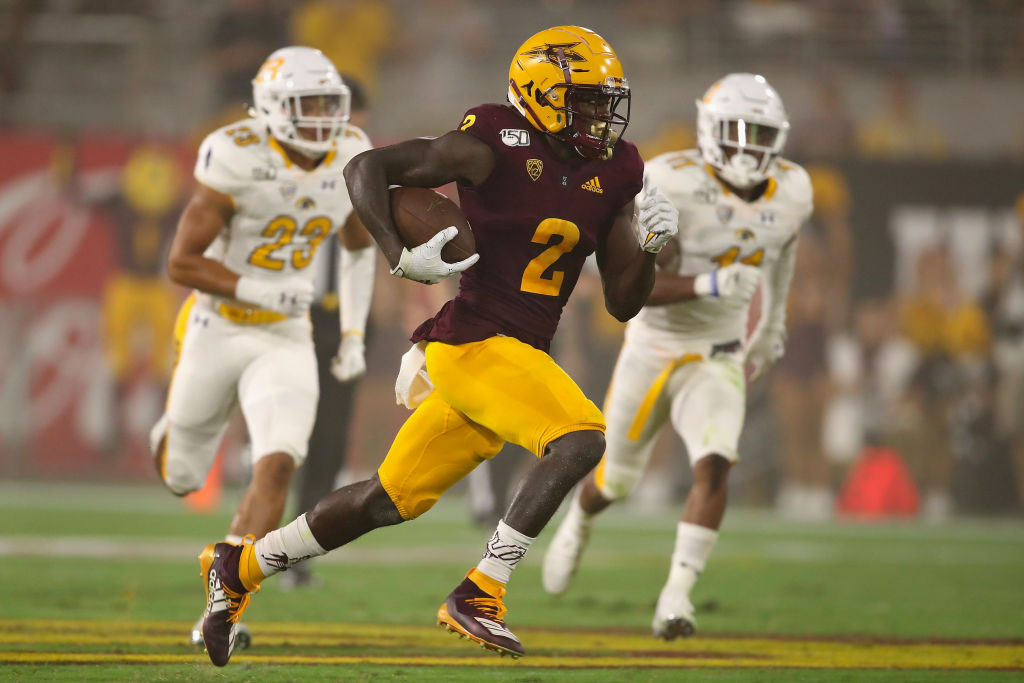
GM John Lynch had a crafty weekend. He traded down one spot with Tampa in the first round and still got the guy the Niners had targeted, defensive tackle Javon Kinlaw. In that deal, Lynch picked up the Bucs’ fourth-round pick—the key element in allowing the Niners to move from 31 to 25 with the Vikes to draft the best receiver on their board (surprisingly), Arizona State’s Brandon Aiyuk. Then Lynch went to work to replace Staley. He phoned Washington and got a very good player, left tackle Trent Williams, for the 156th pick and next year’s third-round choice. Then Lynch dealt his third or fourth back, Matt Breida, to Miami for a fifth-round pick that became a potential swing tackle—West Virginia’s Colton McKivitz.
In sum, Lynch filled his three vital needs on one weekend with playoff-caliber players. That’s what excellent GMs do. No franchise-manager of a playoff team had a better weekend than Lynch.
Chicago: The Bears took what?
As of Saturday morning, the Bears had 10 tight ends on their roster. The Ravens had three. I’ll tell you what it means: The Bears have a head coach, Matt Nagy, who loves the tight end, and loves using multiple-tight-end formations; last year, his top three tight ends (Trey Burton, Adam Shaheen, Ben Braunecker) all ended up on IR. And so Chicago’s first pick of the draft, in the second round, was Notre Dame tight end Cole Kmet.
I’d look for Kmet, Jimmy Graham, the underrated Demetrious Harris and maybe Shaheen to be the four-pack on the roster if and when the season kicks off. A shame about Burton, a great guy and good player who just couldn’t stay healthy; he went to Chicago to prove he was a complete tight end and not just the answer to the who-threw-the-touchdown-pass-on-The-Philly-Special trivia question. He’ll have another chance in Indianapolis, where the position is open after Eric Ebron left for Pittsburgh in free agency.
New England: It’s what the Patriots didn’t do
Bill Belichick could take 10 punters and he’d have enough juice built up to evade any criticism—and rightfully so. (He wouldn’t care if if the ghosts of Grantland Rice and Paul Zimmerman said his draft stunk.) But this was one weird draft for the Patriots. They started with 13 picks, ended up picking 10 players, and took zero at positions of headline need: quarterback and wide receiver. To fill their big holes in the four months since the end of the season, Belichick has acquired Brian Hoyer and Marqise Lee.
“Didn’t work out the last three days. That wasn’t by design,” Belichick told reporters about not picking a quarterback in the draft.
To be fair, this is an offseason like no other in the NFL, because of the uncertainty caused by COVID-19 and because the Patriots are in salary cap jail. And I’m sure Belichick looks at the landscape and thinks, What’s the rush? I might be able to steal a Jadeveon Clowney for a one-year Walmart deal. Not saying Belichick did the right thing on draft weekend, but he knows no one’s going to be practicing football, most likely, till August at the earliest. Four months is plenty of time to remake one’s roster. Three other quarterback thoughts:
1. Belichick took Jarrett Stidham with the 133rd pick last year, and the Patriots like him a lot; is there really any sense to draft a quarterback you don’t love in the fifth round this year, knowing that guy might take away reps from a quarterback you’ve had for a year and want to give a real chance to?
2. I’ve been on the Andy Dalton-for-the-Pats bandwagon. But now that the Patriots have come this far, would it be smarter to sign a Dalton type for a bridge year? Or to give Stidham a real shot and then know for sure whether you’ll need to highly prioritize quarterback in the 2021 draft? Maybe it’s smart to give the gig to Stidham and Brian Hoyer, let the best man win, and just see what you’ve really got.
3. The Patriots signed a Michigan State free-agent, Brian Lewerke, In undrafted free agency Saturday night. He might be more than just a camp arm. (If, of course, there’s a camp.) Impressive guy to some at the combine.
Kansas City: Just what the Chiefs need—another weapon
Do you remember the 2017 season opener, when the Chiefs played the Super Bowl champion Patriots in Foxboro, and rookie Kareem Hunt circled out of the backfield on a wheel route, caught a short throw from Alex Smith and sprinted 78 yards for a touchdown? With the 32nd pick in the first round, the Chiefs might have drafted the new Alvin Kamara, versatile LSU back Clyde Edwards-Helaire, who averaged 6.6 yards per rush and 8.2 yards per catch (on 55 catches) last fall.
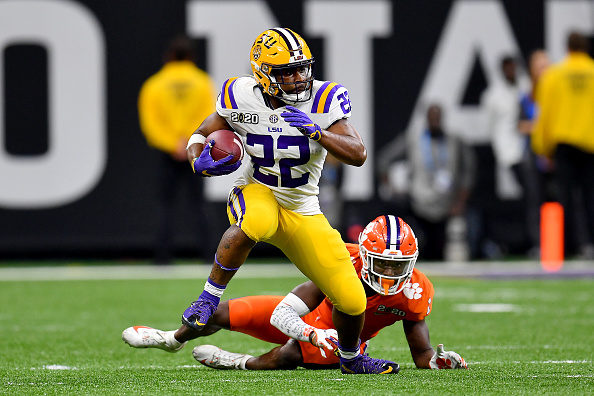
“I told coach [Andy Reid], ‘Wait until you finish up your work on Clyde Edwards-Helaire. He’s going to remind you of Brian Westbrook,’” Chiefs GM Brett Veach said. “Coach called me back and said, ‘He’s better than Brian.’ . . . And Brian was a Ring of Honor player for Philadelphia.”
So the Chiefs kept their top five weapons in the passing game in the offseason, and added a legit threat out of the backfield. The one thing, to me, Patrick Mahomes must be careful about is forming an over-reliance on Edwards-Helaire. He’s got the most dangerous downfield weapons in football, and he’s got to continue to take those shots, every week.
Philadelphia: Ripping the Jalen Hurts pick? Really?
I’m befuddled about something. I hear all this criticism of the Eagles for taking Oklahoma quarterback Jalen Hurts with the 53rd pick in the draft. If there’s one team in football, over the past three years, that’s demonstrated the need for a very good backup quarterback, it’s Philadelphia. The Eagles missed Carson Wentz for six games in 2017 and seven games in 2018; Nick Foles saved the day. Now Foles is gone. Nate Sudfeld was due to be the backup, till Hurts got picked Friday night.
On a good team (which Philadelphia is) with a quarterback who has missed significant time (which Wentz is), the backup quarterback is one of the 10 most important players on the team. Let’s compare the need for a strong backup quarterback to the other Eagle needs when they picked at 53: They could have picked the ninth cornerback or the fifth safety or the sixth linebacker or the fifth running back with the 53rd pick. Or they could have picked a quarterback who you’d think would give Philadelphia a chance to win big games in December and January if he had to play. (A chance, I say; not a certainty.) Hurts, too, can be active and play some role—not altogether like a Taysom Hill, but some sort of role—as a changeup in Doug Pederson’s scheme. Look at the Packers when Rodgers got hurt in 2017, the Niners when Jimmy Garoppolo went down in 2018, the Lions when Matthew Stafford was gone in 2019. All sank like stones.
I don’t know if Hurts would win a playoff game, but I’d sure like his chance to do so more than Sudfeld. And for the 53rd pick, it’s a smart investment.
Cincinnati: Getting Joe Burrow ready
I have a theory about the number one pick in the draft. All the crap Burrow went through in his career—lightly recruited out of Athens (Ohio) High after being Ohio’s Mr. Football; never winning the starting job at Ohio State; getting hurt when it appeared he had a good shot at playing time in 2017; transferring without many options in 2018; having an up-and-down first year at LSU in 2018—gets him ready for this moment. He’ll trying to rescue the Bengals from their three-decade drought without a playoff win.
But there’s another curveball: this weird offseason. Odds are there will be a season, but when will there be real practice? What if Burrow has to go till Labor Day before meeting A.J. Green and Tee Higgins and getting to throw with them? “I wish I was in Cincinnati at minicamp this morning,” Burrow told me Friday. Until then, he’ll have to throw somewhere around his home in southeast Ohio. Problems: His old high school isn’t open and he can’t throw there; nearby, the Ohio University facilities aren’t open either. So he’ll have to find some open fields in the area; he did use a couple of open spaces to throw to a couple of receivers in the run-up to the draft.

“We’re going to have to find a way to manufacture a lot of the physical reps that we could potentially be missing out on all spring,” Bengals coach Zac Taylor told me Saturday night. “If you’re taking a guy that you don’t trust has the work ethic, and the consistency in his daily approach to do that on his own, then you’re going to have problems. We’ve seen this coming for a couple weeks now what this offseason may look like and feel very comfortable that we can handle things virtually on our end, teach him what it should look like, show him on film what it should look like, and then have the trust factor that he’s going to find a way to be creative and manufacture in his backyard, in a field next to his house. . . That’s not just Joe. That’s Tee Higgins. That’s all these guys. We’re going to have to really challenge them: Be creative in how you’ll approach this.”
Seen much that bothers Burrow? I haven’t. “The adversity I’ve had has prepared me for what’s to come,” he said. “One thing that was good advice from Peyton [Manning] was to stay on your routine. Be structured. Win, lose, whatever, be the same.”
Three Questions for Zac Taylor
FMIA: Joe Burrow told me at LSU, they didn’t give him three or four throws at the start of the game to give him confidence, so to speak. And his first three throws in the biggest game of his life last year against Alabama were all downfield throws. Is that something you noticed scouting him?
Taylor: ”It’s funny that you mention that. I know when I was a player—I wasn’t good enough to play in the NFL—it’s always resonated with me. I didn’t like throwing a quick throw. It didn’t get me into a rhythm. I needed to really let my arm go a little bit. And so, it’s fascinating for you to pick up on that. Some quarterbacks need one of those throws where, complete or incomplete, they’re pushing the ball down the field—instead of just guiding those little flareouts in the backfield. Everybody’s different. I feel like Joe is probably the same way [as I was]. He wants to actually make it difficult for early in the game instead of guiding the ball and trying to start three-for-three.”
FMIA: Anything in your offense that you think will be difficult for Joe to learn, particularly with the difficulty of this offseason?
Taylor: ”I don’t think schematically there’s gonna be anything that’s overly concerning with him. It’s just the physical reps of playing against the speed in the NFL. And the different defenses you’ll face and the disguises that those guys can utilize. As smart as you are, sometimes you just need those physical reps. You need to train your eyes to see them at this level. He played in the SEC. You saw how many picks went in the first round from the SEC. It’s gonna get you as prepared as it can. But nothing can replicate what an actual NFL defense looks and feels like on game day, particularly in our division. So, you just want those physical reps as much as you can get them. We’ll take it—every practice they’ll give to us when the time comes. We’ll utilize all of them. Do our best to get up to speed and make sure we account for all those physical reps that may be missing right now.”
FMIA: Regardless of the shape of this offseason, you don’t sound like you have concern about him knowing your offense well enough when it comes time to play the games.
Taylor: “Correct. No concern there.”
Denver: A 24-month metamorphosis
New Denver wide receiver Jerry Jeudy appeared on the Broncos’ virtual Bud Light Draft Party on Thursday night. It was his last night before turning 21, so if the virtual party had been real, Jeudy would not have been able to partake. Cool factoid, and here’s the reason for it: It’s amazing what John Elway has done to transform the Denver offense in the last two years. It’s gone from somnambulant to must-see . . . and I have no idea how it’ll turn out. I just know I’m very interested to watch the Broncos now.
Check out the additions Elway has made to the offense since the 2018 draft, along with current ages: Wideouts Courtland Sutton (24), DaeSean Hamilton (25), Jeudy (21), K.J. Hamler (20); running backs Phillip Lindsay (25) and Melvin Gordon (27); tight end Noah Fant (22); and quarterback Drew Lock (23). Is Lock the luckiest young quarterback in football or what?
Most of Elway’s motivation comes from being in the same division with Kansas City. “We’re going to have to score points to win in our division,” he said. “Obviously at 15 we were thrilled that Jeudy still was there. And going into round two, we were focused on Hamler. He’s explosive and really tough. It’s hard to go 80 yards in this league, and we feel like we drafted two guys who can. Kansas City has those guys, and the quarterback [Patrick Mahomes] is obviously going to be great for a long time.”
The NFL didn’t have a reliable 40 time on Hamler prior to the draft. Once teams scouted him, it became almost needless, because there were multiple plays that showed him outrunning the fastest players on Big Ten defenses weekly. “He had a 100-yard kick return against Michigan,” Elway said, “and so we just figured we’d time him [in a 40-yard interval] on that play. We timed him at 3.93 in the 40, but of course he had a running start. He just has a different speed than anyone else. This has become such a speed game. Watch Kansas City. We love Courtland, we love Jeudy. Get Hamler in the slot against quarters coverage, releasing upfield at 4.3 or 4.32 speed, and that’s going to put a lot of pressure on the safeties, I know that.”
I
“The one concern I have … is I feel like we’re doing good as a country, and we’re in the third quarter, maybe the early fourth quarter, and we’re talking about taking our starters out of the game with a 10-point lead, and I feel like we gotta be smart about this.”
—Saints coach Sean Payton, to Trey Wingo of ESPN on Saturday, on opening the country perhaps before the time is right.
II
“I’m not sure that in our 100-year history we’ve had a finer moment.”
—Commissioner Roger Goodell to NFL staff members around the league after the draft, via Mark Maske of the Washington Post.
III
“As soon as this virus calms down, I’m gonna go in there and compete my nuts off.”
—Fourth-round Colts quarterback Jacob Eason, from the University of Washington.
IV
“I’m feeling pretty good about the rest of my life regardless of what happens with football.”
—Washington quarterback Alex Smith, to Stephania Bell of ESPN, for a terrific E60 documentary about the life of Smith and the arduous recovery from the horrific fractured leg he suffered on the field 17 months ago.
“Project 11” airs Friday on ESPN, and I write more about it lower in the column, in number nine of Ten Things I Think I Think.
V
“There was no relationship. Make sure you put that in there.”
—Former Houston receiver DeAndre Hopkins, now a Cardinal, on how he worked with Texans coach Bill O’Brien, to Greg Bishop of Sports Illustrated.
Hard to blame Aaron Rodgers if he gets frustrated at the lack of drafting and spending on wide receivers by the Packers in recent years—and this weekend. I looked at the last six drafts and the last six free-agency seasons for Green Bay and for last season’s Super Bowl teams, San Francisco and Kansas City. I looked at draftees picked in the top 100 of any draft since 2015 who played wide receiver for their NFL teams, and free agents signed from other teams for $5-million-a-year or more. The results are not good for the Packers.

I
All 255 draft choices were made using encrypted channels on the league’s Microsoft Team draft system. Each team had a designated person to enter the draft picks. Name, position, school. Press “send,” and the NFL’s nine-person draft ops team received it. For instance:
• Denver’s picks were entered by the director of football information systems (the IT guy), Tony Lazzaro.
• Arizona’s picks were entered by the team president, Michael Bidwill.
II
So the NFL sent 32 team caps to all the prospects before the draft. Seeing as though the top prospects were not all gathered in the same place for this stay-at-home draft, the question seemed fair to Joe Burrow, who has been the presumptive number one pick in the draft for three months. No need to send Burrow all 32 caps, right. It would be Cincinnati, holder of the top pick, or pick-plentiful Miami trading up to number one, right? Two caps seemed plenty.
“Did the NFL really send you caps for all 32 teams?” I asked Burrow on Friday.
“I did have all 32 caps here,” he said from his southeast Ohio home. “Now I have to figure out what to do with all the rest of them.”
III
This is no Belichick dog note, but . . .
Queen Elizabeth, the longest-serving monarch in the 1,100-yard history of the British throne, turned 94 last week. She is active, healthy and could serve as Queen for years to come.
Queen Elizabeth took the throne upon the death of her father, King George VI, on Feb. 6, 1952. That means she has been the Queen of England for 10 weeks longer than Bill Belichick has been alive.
I
I wore shorts tonight. Just wanted to honest with you guys.
— Daniel Jeremiah (@MoveTheSticks) April 25, 2020
Draft analyst Daniel Jeremiah, Friday night, after working the second night of the draft for ESPN/NFL Network.
II
NFL meetings next year at the Ritz-Kingsbury.
— Sam Farmer (@LATimesfarmer) April 25, 2020
Sam Farmer covers the NFL, and apparently the architecture of coaches’ homes, for the Los Angeles Times.
III
Antoine Winfield, the dad, played against Tom Brady seven times in his career
Now Antoine Winfield Jr. is his teammate
— Eric Edholm (@Eric_Edholm) April 25, 2020
Edholm covers the NFL for Yahoo Sports.
IV
A Division II second-rounder shows Bill Belichick can sniff out talent anywhere. pic.twitter.com/LSgFlQNTT2
— Jenny Vrentas (@JennyVrentas) April 24, 2020
Jenny Vrentas of Sports Illustrated, commenting on the one of the great scenes in the 2020 NFL Draft.
When the cameras focused on Belichick’s workspace before the Patriots’ first pick of the draft was announced (which was small-college safety Kyle Dugger of Lenoir-Rhyne in Hickory, N.C.), the Pats coach was not there. But there was a split-screen shot on TV, with Patriots director of player personnel Nick Caserio on the right with his kids, and a shot of Belichick’s kitchen table with two laptops on the left, and BILL BELICHICK HEAD COACH chyroned on the left. In the seat was a dog—an Alaskan Klee Kai (small Husky) named Nike.
V
A commercial break when the Jaguars pick is in: A tradition like no other.
— Austen Lane (@A_Train_92) April 24, 2020
Austen Lane is a former Jaguars defensive lineman, and now is a radio host in Jacksonville.
VI
Before Eno Benjamin (7th round, 222nd overall), the last player the Cardinals drafted from ASU?
Turned in this card to draft Pat Tillman in 7th round round of 1998 draft (226th overall) pic.twitter.com/etWjo0kjb7
— Mark Dalton (@CardsMarkD) April 25, 2020
Mark Dalton is the Arizona Cardinals senior VP for media relations.
VII
John Lynch is very good at this GM thing.
— Matt Hasselbeck (@Hasselbeck) April 25, 2020
Matt Hasselbeck, ESPN analyst, is a former NFL quarterback.
VIII
When your GM and Head Coach are neighbors… pic.twitter.com/753mJYVFWo
— Baltimore Ravens (@Ravens) April 26, 2020
Reach me at [email protected] or on Twitter.
He loved this draft. From Frank Edgerly (a former New England scout and high school football coach), of Red Bank, N.J.: “My first draft was in 1983 for one reason—my childhood hero John Elway was in it. I have to say, I don’t know if it’s the circumstances of our lives now or just the break from the traditional format, but I enjoyed this draft experience the most and have really enjoyed seeing the coaches and GM’s interact at home with their kids, who are so often unseen and thought to be non-existent. I think this draft brought realism and humanity to the forefront and I think the average fan had to find some more connectivity to this experience. At a much needed time, I know I felt more connected.”
Thanks for writing, Frank. Excellent points, and so many across America (judging by weekend emails) agree.
Robbie will not be getting a Christmas card from Doug Pederson. From Robbie Ellis, of Philadelphia, via Twitter: “[Jalen Hurts] is the worst pick in the history of the franchise. Just trade Carson Wentz to the Patriots. I’d have more respect for the Eagles if they just told the truth. They have done nothing to help Wentz except pay him. Embarrassing.”
Tell me what you really think, Robbie. I liked the pick, for reasons I explained above. You may not agree, but assuming you’re a rabid Eagle person, you should at least open yourself to an opposing view. Also, they used the 53rd pick, low in the second round, to get Hurts. Was that really a lousier pick than Marcus Smith, Danny Watson, Jon Harris or John Reaves?
Make sense of the Packers, please. From Stephen Poulos, of Boone, N.C.: “You are 13-3, you make the NFC Championship in year one of a new regime and you have Rodgers tied up to a new contract and who wants to keep playing. You pick [quarterback] Jordan Love? Why? Then you take running back A.J. Dillon, who has ton of carries in college plus you have Aaron Jones and Jamal Williams already. Hope this all works out but don’t see any of this working out.”
Well, I wrote about the Rodgers-Love thing higher in the column, and talked to GM Brian Gutekunst, whose position is clear. He’s trying to take care of the long-term in Green Bay with a 36-year-old quarterback. My biggest issue (please see my Numbers Game section) is how the Packers historically—and very much recently—ignore the wide receiver position. No prime free-agent wideout signed in the last five years, and no wideout drafted in the top 130 picks in the last five drafts. I’d have to go to football school for a long time to understand why a team doesn’t address a position of need that consistently, particularly in the three drafts since Jordy Nelson left, and in the two post-Randall Cobb.
You think like a GM, Ryan. From Ryan: “I like this defensive tackle, Ross Blacklock, who the Texans drafted in the second round to fill a need with the departure of D.J. Reader in free agency. From what I see, this kid is fast. He grew up playing five sports so he’s a true athlete. I think he can be a more productive player than Reader. The Texans drafted well and filled a huge need while also avoiding a $13-million-a-year contract with Reader.”
You might be underrating Reader, who I like a lot. But you are right: The draft is to fill holes brought on by things like free-agent departures, and the Texans definitely need some new blood on the front seven. Blacklock should be able to play early; I think he ended up lasting till the 40th pick because of a torn Achilles in 2018. He came back strong last year, and should be a good pro.
This is what the league will be mulling in the next few months. Promise. From Jeff F., of Bethesda, Md.: “Understanding there are many unknown variables to play out, what impact do you see this remote draft having for future drafts? Will the NFL set up more reaction cams with late-round picks? Things outwardly seem to be going well with this draft. Keep up the excellent work, FMIA is one of the few bright spots remaining!”
Thanks for the kind words, Jeff. In covering the NFL for a long time, I’ve found the one thing execs there do is take what just happened and study all aspects of it pretty thoroughly. They’ll do that here. As I wrote early, I’d watch for the league to take elements of this draft and add them to the 2021 telecast. Only problem is, the best part was the Belichick-dog and family-hug moments; if coaches go back to draft rooms, those things disappear.
1. I think, with such a national emphasis on trying to do the right thing during the coronavirus, it’s right today to praise the fundraising efforts of the NFL (money raised by the weekend Draft-A-Thon, and by player and owner and staff contributions), which now exceed $100 million. It’s also important to recognize Sean Payton, who recovered from a March bout with COVID-19 and last Monday sat in the New Orleans Blood Bank to give plasma. Plasma can make the difference between life and death for patients in deep trouble with the coronavirus. “He is truly giving a lifetime to someone else, and perhaps several people,” said Dr. Tim Peterson, the medical director of the New Orleans Blood Bank. “He could have and probably did save someone’s life.” Peterson said Payton has an uncommon blood type that was in need last week, and the donation was put to immediate use to help a patient suffering from coronavirus. Payton said he’d give again if given the chance.
2. I think ESPN has to examine its draft practice of being Debbie Downers in the middle of players’ best moments. Such as the graphic when Tee Higgins got picked by the Bengals. It listed his hometown, his basketball prowess, and his sister playing college basketball . . . and his mother: “Mom, Camillia, fought drug addiction for 16 years.” Seemed a little rough, a little inappropriate, bordering on tabloid fodder. I asked Seth Markman, the ESPN executive, about it Sunday.
“I heard [the criticism],” he said. “It’s not unfair. It’s something we should self-scout for the future. It’s something we can examine. We didn’t want to be Debbie Downer, but we wanted to show how some of the players overcame major issues in their lives. Maybe how Javon Kinlaw drew inspiration from growing up homeless, or a player overcoming a father’s suicide to achieve his dream.”
No question ESPN will tweak that next year—and the network certainly should.
3. I think it seems like a month ago, not a week, the Bucs signed Rob Gronkowski. Four thoughts:
a. Hard to know who the real Gronkowski is right now, after battling through three injurious seasons. He missed eight games in 2016, two in 2017 and three games in 2018, then took 13 months to see what the real world was like. He’ll certainly be an intriguing player for Tampa Bay and perhaps a great one again, but I’d be careful about thinking of him as a full-game player with the kind of classic Gronk impact. I’d hang on to both Cameron Brate and O.J. Howard if I were the Bucs.
b. Even though I have no idea what to expect, I like the signing because of the chance Tampa’s taking—going all-in for a year or two to make a legitimate run at a Super Bowl. That should be what sports is about.
c. GM Jason Licht likes the culture addition too. “He’s an incredible teammate. I know—I was there,” said Licht, the Pats’ director of player personnel in 2011 when Gronkowski was drafted in New England. “He loves the game and he loves Tom Brady. He’s wired the same way as Tom.”
d. I don’t see Gronkowski playing for Tampa Bay with Brady as a smackdown (no pun intended) of the Patriot Way. New England likely would have tried to make a returning Gronkowski fit in their very tight cap situation this year, but why? They want to move forward with younger players who wouldn’t be the same kind of injury risk. And why would Gronkowski want to play in a retooling situation? He’d been there, done that.
4. I think Joe Staley deserves more than a heartfelt public statement announcing his retirement, and I hope the Niners do something significant for him when a public tribute is appropriate. He was a legitimate all-decade tackle, playing for so many different Niner regimes (Singletary, Harbaugh, Tomsula, oh my!). I’ll never forget one of the great downfield blocks by an offensive lineman in NFL history, from the Niners’ 36-32 win over the Saints in the 2011 playoffs.
This will always be my favorite Joe Staley highlight 🐐 | #49ers @jstaley74 pic.twitter.com/YM1qkE86Fv
— OurSF49ers (@OurSf49ers) April 25, 2020
5. I think one of the greatest things I saw all weekend—and there was a multitude of them—was the fourth-grade essay written by Colts third-round pick Julian Blackmon. He tweeted it out Saturday:
A letter I wrote in the 4th grade🙏🏾 pic.twitter.com/2iWLq6wMym
— Jülian Blackmon (@JumpManJuice23) April 25, 2020
6. I think if I were a coach with interest in buying a lottery ticket for an offensive weapon, and if Percy Harvin would be willing to sign for zero guaranteed money, I’d bring him to camp . . . if there is a camp before the 2020 season. Some issues: Harvin—Josina Anderson reported he wants to make a comeback—will be 32 this fall, he has not played since 2016, and he played only 306 snaps combined in 2015 and ’16. I still would sign him. Remember his 87-yard kick-return TD in the Super Bowl six years ago? Key phrase: “six years ago.” But at his best, he was one of the two or three most dangerous weapons in the game, Tyreek Hill before there was a Tyreek Hill. Intriguing, and at 32, Harvin would be an interesting trial for some team. Steelers? Patriots? Falcons?
7. I think Mike Mayock likes the big conferences that play big-time college football. In his first two drafts as GM of the Raiders, he’s made a total of nine picks in the top 100: Clemson three, Alabama two, and one each from Ohio State, Mississippi State, South Carolina and Kentucky. And his first pick in the fourth round? Another Clemson player, guard John Simpson.
8. I think the Jordan doc is getting all the attention these days, and the insider look at the greatness of Michael Jordan is certainly worth it. But ESPN’s going to have a heck of a doc on the air Friday. The E60-produced “Project 11” focuses on the life, major injury, 18 surgeries, near-leg-amputation, rehab and recovery of Washington quarterback Alex Smith after his November 2018 fractured leg. I screened it the other day, and the crew—ESPN’s Stephania Bell, also a physical therapist in orthopedics and sports medicine, is excellent as the reporter of the piece—clearly gained the trust of Alex and Elizabeth Smith. The Smiths pour out their hearts to Bell, as do the doctors who treat Alex Smith after an on-field injury against the Texans 17 months fractured his right leg grotesquely and threatened his life. We’d heard a series of whispers and stories about Smith being in danger in the weeks after the injury, and this documentary delves into just how dark it got.
What’s so real, and so stunning, is that Alex Smith and the doctors okayed the usage of images of his right leg throughout the process. It’s really impactful to see the reality of an infected and contaminated wound, particularly through the process of the eight debridements (the removal of infected, dead or damaged tissue). It’s emotional to hear Elizabeth Smith describe the hours and days watching Alex in the hospital, fearing for his life. “My husband is laying there and he’s dying,” she tells Bell. It’s also emotional to hear Elizabeth ask the surgeon, when Alex’s life and limb are in extreme danger, what the doctor would do if it was her leg.
All in all, this will be an hour very well spent (Friday, 7 p.m. ET, ESPN), particularly with America so homebound. You’ll cry. You’ll also come away with such admiration for how the Smiths fought through the process, and the incredible perspective of Alex Smith, who somehow through it all, in a dark time, found the bravery to say to his wife: “Do you know how many people would love to trade positions with me?”
Something that occurred to me watching it: The Smiths deserve credit for laying their lives bare. This is not just a TV show. It’s a real-life story that very truly could have taken a tragic turn. “It’s a testament to Alex and to Elizabeth, and them being authentic,” Bell said the other day. I’m glad they did it, if only for people in the future who might go through something as life-changing as the Smiths did.
9. I think once and for all time we should rid the term “hogmolly” from the football lexicon. Not only is it derogatory (check Urban Dictionary) but it is absolutely, positively a meaningless waste of three syllables. We’ve gotten used to huge offensive linemen being called hogmollies, and usually it sounds so silly that it brings a smile to some faces. I sound like some old man bitching about it, and I suppose I am. But it’s just a dumb term, even when you don’t know what the slang of it means.
10. I think these are my other thoughts of the week:
a. Should have read this story a month ago—about glasses fogging while wearing the masks, from Lisa Boone of the Los Angeles Times. Been driving me crazy, really.
b. Obit of the Week: Katharine Q. Seelye of the New York Times on the most amazing tragi-coincidence of the pandemic—100-year-old World War II hero Philip Kahn died April 17 of the coronavirus on Long Island, 100 years after his infant twin died of the Spanish flu.
c. How incredible is that? And this: Seelye reports that, late in life, Philip Kahn told his son Warren: “Warren, my boy, I told you history always repeats itself.”
d. Coronavirus Story of the Week: Andrew Kelly and Clare Baldwin of Reuters on the arduous, nearly impossible jobs of female morticians in New York City, “Dealing with the dead: The female undertakers of Harlem.”
e. Lord. One of the morticians said: “You want a cremation? I’m sorry, no. You want a burial and you already have a plot and everything? Sorry, no. We don’t have any room. We’re being told that we’re heroes for being on the front lines of this but I feel like I’m failing families every day.”
f. Wrote Kelly and Baldwin: “On the front lines of the coronavirus pandemic, nurses and doctors are caring for the living. But there is another front line of those caring for the dead. They fear they can also get infected and die. Some of them have sent their own children to live with relatives. And because American cities like New York were never designed to dispose of so many dead, their call of duty will last much longer.”
g. The MMQB Alumnus Story of the Week I: Robert Klemko of the Washington Post, reporting from Cheyenne, Wyo., on the divided sentiment over closing society because of the virus.
h. From Klemko: “The death toll in Wyoming thus far? Two.”
i. Klemko!
j. The MMQB Alumnus Story of the Week II: Kalyn Kahler, writing for Sports Illustrated about a late-round anonymous prospect in the draft, Prospect X, getting access to his life as he tries to make a team fall in love with him—either in the late rounds of the draft or as a priority free agent.
k. Kahler watched one NFL scout interview Prospect X over FaceTime, and wrote:
His team wants X badly but may not be able to draft him, so he needs to figure out whether the interest is mutual should X go undrafted. Does he love me? Does he love me not?
“You been talking to a lot of teams?”
“Yep,” X says confidently. “I’ve been talking with quite a few. Tomorrow I have another video chat with a special teams coordinator with [an NFC team].”
Late-round/priority-free-agent prospects rarely give a straight answer when asked about their team preferences. X is no exception to that rule.
“The [NFC team]?” the scout jokingly scoffs. “Why do you want to go there?”
. . .
The scout laughs and tries his question one more time. “If you could go anywhere, where would it be?”
Prospect X slips the question like a skilled boxer. “I’m going to be honest with you,” he says, leaning back on the couch in his living room. “I’ll be grateful wherever. As long as I have a number and my name on the back of my jersey, that’s all I really care about. Hell, you can give me number 99, since that’s going to be my overall [rating] in Madden someday.”
X’s dad walks through the room, and the scout calls him into the conversation. They’d met at X’s pro day, and the scout remembers dad is an avid golfer. “Hey, Pops, how are you?” the scout says. “You know there are great courses out in [team’s city].” “I like the sound of that,” Dad says. A few days after the FaceTime call, a package addressed to X’s dad shows up at the family’s doorstep. Inside is a box of his favorite brand of golf balls, Titleist Pro V1 balls, stamped with the logo of the scout’s team.
l. Outstanding stuff from Kahler about how late-round guys get recruited in case they don’t get drafted. Talk about a reporter who has taken advantage of an opportunity—that’s Kalyn. By the way, Project X turned out to be a free-agent signing in the AFC. More from Kahler on him this week.
m. Reporting of the weekend: ESPN’s Adam Schefter with one report that Washington had traded tackle Trent Williams to San Francisco for third and fifth-round draft picks; 35 minutes later, Schefter reported why the trade happened: stalwart left tackle Joe Staley was expected to retire.
n. Radio Story of the Week: Corey Turner of National Public Radio on school counselors handling the emotions of students around the country who, collectively, have gotten their spring terms and sports seasons and proms and graduations called off. Turner on an Illinois high school counselor, Franciene Sabens:
Students are also experiencing a kind of grief “over what they’ve lost,” Sabens says, especially seniors. “Losing out on the end of their senior years — something that they’ve dreamed about their whole life . . . has really been overwhelming for them. So there have been a lot of tears. There have been a lot of questions . . . ‘What did we ever do to deserve this?’”
Unfortunately, there are no easy answers. Instead, Sabens says, she tries to let students know “that it’s OK to not be OK. I mean, most of the world is not OK right now . . . It’s OK to grieve about what you’re losing because it is tragic.’ “
o. Really important to realize the most important spring of so many kids’ lives just got erased. It’s going to leave a mark, for sure.
p. What a career you had, Muffet McGraw. Congratulations. This great Notre Dame women’s basketball coach, coached with class every day.
q. Talk about something that needed to be said, and said by a highly respected and accomplished person . . . McGraw from a year ago, on the lack of women in positions of consequence in our world:
“We don’t have enough female role models, we don’t have enough visible women leaders, we don’t have enough women in power. Girls are socialized to know when they come out, gender roles are already set. Men run the world, men have the power, men make the decisions. It’s always the man that is the stronger one. And when these girls are coming up, who are they looking up to tell them that that’s not the way it has to be? And where better to do that than sports? All these millions of girls who play sports across the country, they could come out every day, and we’re teaching them some great things about life skills. But wouldn’t it be great if we could teach them to watch how women lead?”
r. I see bowling alleys and tattoo parlors are now essential businesses in Georgia. Not sure what is more essential—those two places, or professional wrestling in Florida.
s. Carolyn Goodman, the Las Vegas mayor, to Anderson Cooper, on the job of businesses in her city to act on their own to be sure their businesses are safe when they open: “They better figure it out. That’s their job. That’s not the mayor’s job.”
t. We do not have the will to stop this virus, seems to me.
u. Imagine all the college and high school sports teams and activities and lifetime memories that will not happen this spring. Unavoidable, but really sad. I watch this video of my good friend Ken Fost’s grandson and his Grinnell (Iowa) College baseball team and think of those thousands of teams and activities that got erased this spring.
v. So I liked Luke Bryan’s Saturday afternoon country song interlude, and I’d never heard of H.E.R., but I liked that song too. Sounds like I’m in the minority there.
w. A shoutout, today, to all those who worked on the draft TV coverage over the weekend. It was really fun, and it was real. I asked Jeff Darlington of ESPN, a good friend, to reflect on what such a strange but important assignment on draft weekend was like for him. He wrote back in an email:
“When I used to daydream about the prospect of reporting on the NFL for ESPN, I’m not real sure I envisioned appearing on television moments before the start of the NFL draft, while seated six feet from my washer and dryer as my son stood behind an iPhone camera that would send its live signal to homes across the country. I’m generally reporting from the field, and most sports reporters have endured some pretty challenging circumstances. But this one was unique for reasons that never really interfere with road assignments: family. My wife works a full-time job for a medical records company—so she’s actually doing ‘real-world’ work that’s far more important to our current circumstances. All week, both of us were essentially trying to also watch our two young children (5 and 2) while doing our jobs. It’s a scenario millions of Americans can understand, which is probably what helped us get through it. At one point, my wife was on a scheduled conference call for her job. And my daughter, who isn’t potty trained but has conveniently decided she no longer loves diapers, was running naked through the house saying she had to poop. So my wife was on a call—and I was unexpectedly needed to jump on TV as soon as I could get my garage ‘studio’ fired up. All while my 5-year-old son was throwing a fit because he also wanted to go on TV with me. It was stressful, for sure. But we’re in this current space where every time I’d get stressed, or think how weird it is, I’d remember this is really nothing compared to the real challenges people are facing.
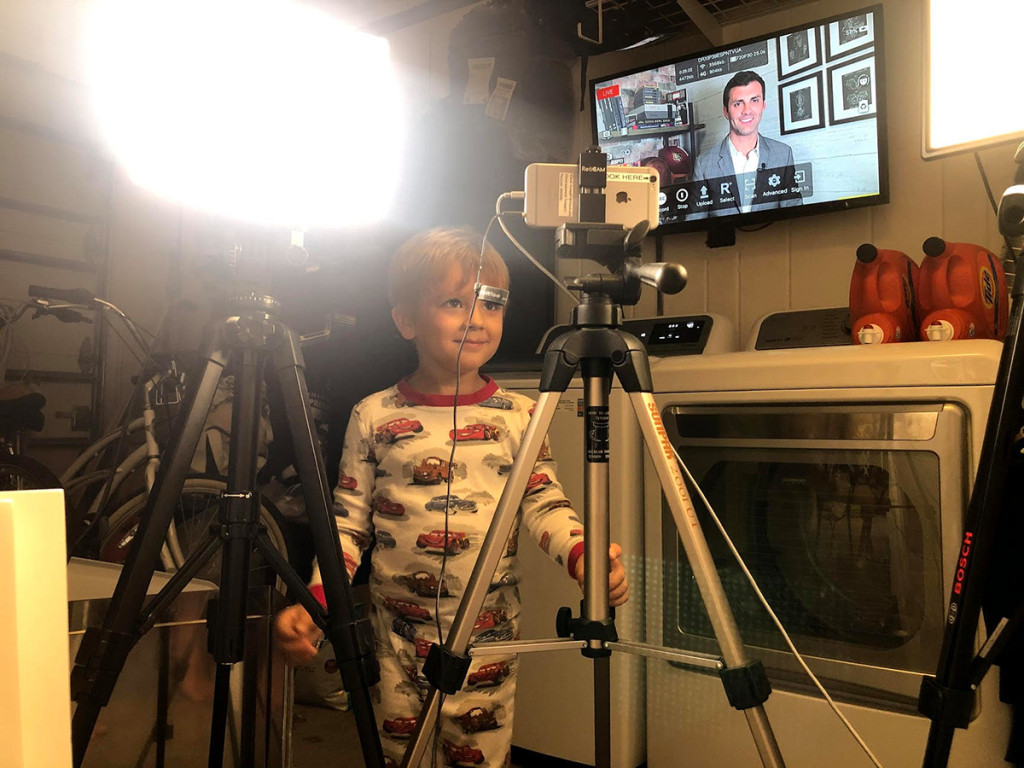
“Still, some funny moments. Like trying to converse with one GM about trade possibilities while filling a kiddie pool with water in the backyard. Or another time, when I was using one hand to talk on my phone to a high-ranking source who was causing me to question some very strong intel about the Dolphins taking Tua Tagovailoa at No. 5, while using my other hand to help my son try to catch lizards with a net in our neighbor’s yard. I’ll certainly never forget these last few months. Living the dream, indeed.
x. Just great, Jeff.
y. So now what do we do?
My future draft thought:
Folks loved this draft’s homey feel.
Just say no to glitz.

